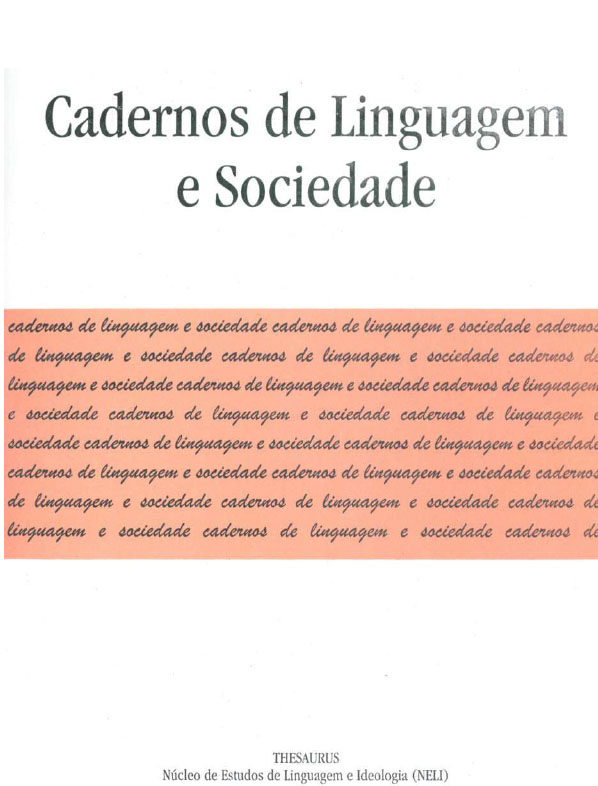Lingüística como padrão de escrita missionária
DOI :
https://doi.org/10.26512/les.v2i1.2949Résumé
This paper presents the history of two models of orthography for unwritten languages created by evangelical missions, using linguistic concepts. Their diffusion will be analysed as well as the linguistic concepts adopted for the notion of letter and the alliances established between scholars and missionaries in the formulation of these models.
Téléchargements
Références
American Bible Society. A guide for translators, revisers and editors working in connection with the American Bible Society. New York, apêndice de Nida, E. Bible translating, 1932 (1947).
Asamblea de Filologos y Lingüistas. Memória. México, Departamento Autônomo de Asuntos Indígenas, 1940. Buescu, M. L. C. A gramaticalização das línguas exóticas no quadro cultural da Europa do século XVI. Revista de História Econômica e Social, 10:15-28,1982.
Clammer, J. R. Literacy and social change: a case stndy ofFiji. Leinder: E. J. Brill, 1976,218 pp. Fishman, J. Ethnocultural issues in the creation, substitution, and revision of writing systems. In: Rafoth, B. & Rubin, D. L. (eds.) The social construction ofwritten communication. New Jersey: Ablex Publishing, 1988, pp. 273-286. Gleason, H. A. Linguistics in the service of the Church. Practical Anthropology, 9(5)205-219, 1962.
Gudschinsky, S. C. Handbookof literacy. SIL, Glendale, CA, 1951. Harris, R. The language makers. London: Duckworth, 1980.
Hefley, J. & Hefley, M. Uncle Cam: The story of William Cameron Townsend,founder of the Wycliffe Bible Translator and the Summer Institute of Linguistics. Waco: Word Books, 1974.
Investigaciones Linguisticas. México, Instituto Mexicano de Investigaciones Linguisticas, 1933-1938.
Jones, D. The history and meaning ofthe term "phoneme ". International Phonetics Association. Londres, 1957. Lepsius C. R. Standard alphabet for reducing unwritten languages and foreign graphic systems to a uniform orthography in European letters. 2nd ed. London: Williams & Norgate, 1863.
Mauer, D. Tahiti de laparole a l 'écriture. Nouvelles Editions Latines. Paris: Dossier, 20, 30 pp., s.d.
Nida, E. Bible translating: an analysis of principies and procedures with special reference to aboriginal languages. American Bible Society. New York, 1947, 359 pp.
Olson, D. How writing represents speech. Language and Communication, 13(1)1-17,1993 Pike, E. Ken Pike, scholar and Christian. SIL. Dallas, 1981.268 pp.
Pike, K. Practical suggestions toward a common orthography for Indian languages of México for education ofthe natives within their own tongaes. Investigaciones Lingüísticas. Instituto Mexicano de Investigaciones Linguisticas, V (1-2) 86-97, 1938.
Pike, K. Phonemics: a technique for reducing languages to writing. Ann Arbor: University of Michigan Press, 1971, 254 pp.
Ramirez, F. C. Fonética dei Tarasco: necesidad de adoptar una ortografia para los idiomas indígenas. Investigaciones Lingüísticas, 2: 422-427,1934.
Stoll, D. Pescadores de hombres o fundadores de império? Lima: DESÇO/ Centro de Estúdios y Promoción dei Desarrollo, 1985,489 pp.
Summer Institute of Linguistics.Zifôraçy in the 90s: The role ofthe Summer Institute of Linguistics. 1990,25 pp. Swadesh, M. The phonemic principie. Language, 10:117-129,1934. Swadesh, M. El alfabeto y Ia labor de alfabetización. Primer Congreso Indigenista Interamericano. 1940a, pp. 271-274, mecanografado.
Swadesh, M. Métodos de Ia alfabetización en lenguas nativas. Primer Congreso Indigenista Interamericano. 1940b, pp. 275-280, mecanografado.
Swadesh, M. El Proyecto Tarasco: Ia ensenanza en lengua nativa. Primer Congreso Indigenista Interamericano. 1940c, pp. 281-286, mecanografado.
Townsend, W. C. & Griset, E. Camp Wycliffe Chronicles, 1 (2) 1936. Winter, W. Tradition and innovation in alphabet making. In: Coulmas, F. & Ehlich, K. Writing infocus. Mouton Publishers, 1983, pp. 227-238.
Téléchargements
Publié-e
Comment citer
Numéro
Rubrique
Licence
Autores/as que publicam nesta revista concordam com os seguintes termos:
Autores/as mantêm os direitos autorais e concedem à revista o direito de primeira publicação, sendo o trabalho simultaneamente licenciado sob a https://creativecommons.org/licenses/by-nc-nd/4.0/o que permite o compartilhamento do trabalho com reconhecimento da autoria do trabalho e publicação inicial nesta revista.



